Salmon Onigiri: Step-By-Step Recipe
Salmon Onigiri is a delicious and popular Japanese dish that has been enjoyed for many years. Onigiri, in general, is a traditional Japanese food. It’s made by shaping steamed rice into a ball or triangle shape and adding a filling. The filling can be anything from salmon to tuna to pickled vegetables or even Umeboshi. It is a type of Japanese pickled plum.
Salmon Onigiri, in particular, cook by first making fresh or canned salmon. Then, mix it with other ingredients like soya sauce, mirin, sake, and green onions. The cooked salmon is then added to the steamed rice along with any other fillings. And the mixture form into a ball or triangle shape. The Onigiri then wraps in nori seaweed. It not only adds a salty flavour to the rice but also helps to keep it moist.
You can enjoy Salmon Onigiri as a meal or a snack and is a great option for those looking for a quick and easy-to-make meal. It is also a popular food item in Japanese convenience stores. It is often pre-packaged and sold as a grab-and-go item.
In addition, one of the great things about Salmon Onigiri is that it is a nutritious and filling meal. Salmon is a great source of protein, omega-3 fatty acids, and other important nutrients. Rice, which is the base of Onigiri, is also a good source of carbohydrates. It provides energy to keep you going throughout the day. The addition of other ingredients like green onions, soya sauce, and mirin. It adds flavour and depth to the dish, making it even more enjoyable.
What is Salmon Onigiri?
Salmon Onigiri is a Japanese dish made of a ball or triangle-shaped rice ball filled. It cooks with salmon and other flavourful ingredients. Onigiri is a traditional Japanese snack or meal that people eat on the go or as a packed lunch. The salmon used in salmon Onigiri can be fresh or canned. It mixes with soya sauce, mirin, sake, and green onions to add flavour. The rice ball then wraps in nori seaweed to keep the rice moist and also to add a savoury flavour. Salmon Onigiri is a popular food item in Japanese convenience stores. It can act as a nutritious and filling meal or snack.
Why This Recipe Works
The recipe for salmon Onigiri works for several reasons:
- Flavourful ingredients: The mix of cooked salmon, soya sauce, mirin, sake, and green onions. It creates a delicious and savoury flavour that complements steamed rice.
- Quick and easy to eat: Salmon Onigiri is a great option for a meal on the go or as a packed lunch because it is easy to carry and eat with your hands.
- Nutritious and filling: Salmon is a good source of protein and omega-3 fatty acids. Since rice provides energy from carbohydrates and together they create a satisfying and nutritious meal.
- Customisable: Onigiri can consist of a variety of fillings. It makes it easy to customise to your preferences or dietary needs.
- Simple to make: The salmon recipe Onigiri is simple. In addition, it requires only a few ingredients and basic kitchen tools. This makes it a great option for beginner cooks or those with busy schedules.
Ingredients Required to Make Salmon Onigiri
Here is a description of the key ingredients you will need to make salmon onigiri:
- 14 oz Japanese short-grain rice: This type of rice is known for its short, plump grains and sticky texture. It is the preferred type of rice for making sushi, including nigiri. For this recipe, you will need 14 ounces or about 400 grammes of cooked Japanese short-grain rice. The rice is seasoned with a mixture of salt. Sugar, vinegar and rice. It gives it a tangy and sweet flavour.
- 2 Nori sheets: Nori is a kind of dried seaweed that’s used to wrap sushi rolls, including nigiri. It has a little salty flavour and a crisp texture when toasted. For this recipe, you will need two sheets of nori, which will be cut into small strips to use as a base for the nigiri.
- Salt: Next, A pinch of salt add to the cooked rice to enhance its flavour.
- 1 Salmon filet: The salmon filet is the star ingredient in this recipe. It should be fresh and of high quality. When sliced thin and placed on top of the rice, the salmon should be tender, moist. It should have a delicate, buttery flavour.
All in all, salmon nigiri is a simple but elegant dish that showcases the beauty and flavour of sushi at its best.
Tools Required to Make Salmon Onigiri
Here are the tools you’ll need:
- Rice cooker or pot with lid: To cook the sushi rice, you will need a rice cooker or a pot with a lid. Rinse the rice until the water runs clear, then add it to the rice cooker or pot along with the water. Cook according to the manufacturer’s instructions or bring to a boil. Lastly, Reduce the heat to low, and simmer for about 20 minutes until the rice is tender and fluffy.
- Wooden spoon or rice paddle: Use a wooden spoon or rice paddle to gently mix the cooked rice and let it cool. Avoid using a metal spoon as it can damage the delicate grains of rice.
- Small saucepan and fork: To make the salmon filling, you will need this to cook the salmon mixture. Combine the cooked salmon, soya sauce, mirin, and sake in the saucepan. Heat over medium heat until the liquid has been absorbed and the mixture is heated thru. Use a fork to flake the salmon into small pieces.
- Small bowl: Transfer the salmon mixture to a small bowl and stir in the chopped green onions. Mix well to combine and let the mixture cool a little.
- Plastic wrap or tea towel: To shape the Onigiri, use a piece of plastic wrap or a clean tea towel. Use it to prevent the rice from sticking to your hands. Place a small amount of rice in the centre of the plastic wrap or tea towel, and make a small indentation in the centre.
- Salmon filling: Add a spoonful of the salmon mixture to the indentation in the rice.
- Shaping: Use the plastic wrap or tea towel to shape the rice around the filling into a ball or triangle shape. Press the rice to ensure that it sticks together.
- Nori seaweed sheets (optional): If using nori sheets, cut them into small squares. Wrap them around the Onigiri to keep the rice moist and add a savoury flavour.
Salmon Onigiri Recipe
Servings: 4 Onigiri Course: Snack, Main Course Cuisine: Japanese Prep Time: 5 minutes Cook Time: 5 minutes Total: 10 minutes
Salmon nigiri is a popular type of sushi. It features a slice of fresh salmon on top of a small ball of seasoned Japanese short-grain rice. The quality of the ingredients used in making this dish is key to its success.
To make salmon Onigiri, start by cutting a Nori sheet into three equal pieces. Next, grill a salmon filet and break it into flakes. Gather all the necessary ingredients. It includes a pinch of salt, cooked rice, the salmon flakes, a bowl of water and Nori sheets.
To assemble the Onigiri, put the rice in a bowl and make a small dent in the centre. Add one or two teaspoons of salmon flakes to the dent. Wet your hands with water and sprinkle some salt (about two fingertips) on your palm. Rub your hands together to distribute the salt evenly.
Take a handful of rice. Shape it into a triangle or round shape by pressing with both hands while rolling it several times. Repeat this process until all the rice and salmon are used up.
Finally, wrap each Onigiri with a piece of Nori sheet. Serve and enjoy your delicious salmon Onigiri!
Salmon Onigiri: Nutritional Information
Serving: 1 serving
Calories: 188 kcal
Carbohydrates: 32 g
Protein: 8.8 g
Fat: 8 g
Cholesterol: 12.8 mg
Sodium: 218.9 mg
Tips to Make the Best Salmon Onigiri
Here are some tips to make the best salmon Onigiri:
- Use short-grain sushi rice: Short-grain sushi rice is stickier than regular rice. It is perfect for making Onigiri. Rinse the rice before cooking to remove excess starch. Prevent it from becoming too sticky.
- Cook the rice: In addition, To make perfect Onigiri, you need to cook the rice. Use the right amount of water and follow the cooking instructions to ensure that the rice is tender.
- Use fresh salmon if possible: If using fresh salmon, cook it first and then flake it with a fork. In addition, If using canned salmon, drain the liquid before flaking it.
- Use flavourful ingredients: To make flavourful Onigiri, use ingredients. For instance, soya sauce, mirin, sake, and green onions season the salmon mixture.
- Let the rice cool: It’s important to let the rice cool a little before shaping the Onigiri. If the rice is too hot, it will be difficult to handle and may fall apart.
- Keep your hands moist: Wet your hands with a little water before shaping the Onigiri. Do it to prevent the rice from sticking to your hands.
- Experiment with fillings and toppings: Onigiri can consist of a variety of fillings. Try different combinations of ingredients to find your favourite.
- Use plastic wrap or a tea towel to shape the Onigiri: Using this will make it easier to shape the Onigiri. It shapes without getting rice all over your hands.
By following these tips, you can make delicious and authentic salmon Onigiri. It would be perfect for a quick and tasty meal or snack.
Storing & Freezing
Storing and freezing salmon Onigiri is easy] and it’s a great way to have a tasty and convenient snack or meal on hand whenever you need it.
To store salmon Onigiri, wrap them alone in plastic wrap. And store them in an airtight container in the refrigerator for up to 2 days. When ready to eat, remove the plastic wrap and enjoy.
Moreover, You can also freeze them. To do so, simply wrap them in plastic wrap. Then, store them in an airtight container in the freezer for up to 2 months. To thaw, remove the Onigiri from the freezer. Let them sit at room temperature for 1-2 hours, or microwave them on low power for a few seconds until they are thawed and heated thru.
It’s important to note that freezing can alter the texture of the rice. So the Onigiri may not be as soft and fluffy as when they were freshly made. Yet, they will still be delicious and convenient for a quick meal or snack.
Lastly, When reheating frozen salmon Onigiri, you can microwave them on low power for a few seconds. Continue until they heat thru, or wrap them in foil and heat them in the oven at 350°F for 10-15 minutes.
FAQs
What Can You Put Inside Onigiri?
Onigiri can fill with a variety of ingredients to suit your taste preferences. Here are some popular fillings for Onigiri:
- Salmon: Flaked cooked salmon seasoned with soya sauce, mirin, and green onions.
- Tuna: Flaked canned tuna seasoned with mayonnaise, soya sauce, and green onions.
- Umeboshi: Pickled plum, often found in Japanese grocery stores. It adds a tangy and salty flavour to Onigiri.
- Katsuobushi: Dried and smoked bonito fish flakes are a popular filling for Onigiri in Japan.
- Shiozake: Salted salmon, often found in Japanese grocery stores. It adds a savoury flavour to Onigiri.
- Teriyaki chicken: Cooked chicken marinated in teriyaki sauce and diced into small pieces.
What Is The Difference Between Onigiri And Sushi?
Onigiri and sushi are both popular Japanese dishes. They are often confused with each other, but they are different in several ways.
Onigiri is a rice ball made from short-grain Japanese rice. It seasons with salt and is stuffed with various fillings. For instance, salmon, tuna, pickled vegetables, or umeboshi (pickled plum). Onigiri shapes into a triangular or cylindrical shapes. They are then wrapped with a piece of dried seaweed (nori).
Sushi is a dish made from vinegared sushi rice topped with raw fish or other seafood. It serves with wasabi and soya sauce. Sushi can also cook with cooked or cured fish, vegetables, or other ingredients. And is often serves in bite-sized pieces.
Lastly, While both dishes are made with rice, Onigiri chooses as a snack or a light meal. While sushi serves in restaurants and is considered a more formal dish.
Does Onigiri Use Raw Fish?
Onigiri cooks with a variety of fillings. For instance, raw fish, but it’s not a common or traditional filling. Raw fish is more used in sushi, which is a different dish than Onigiri.
Onigiri fills with cooked ingredients. For instance, grilled or poached salmon, pickled vegetables, or seasoned tuna. This makes it a convenient and portable snack. It is enjoyable when you’re in a rush without the need for refrigeration.
Is Onigiri Raw Or Cooked?
Onigiri consists of cooked rice. The rice in Onigiri is short-grain Japanese rice. It should steam and season with salt. In addition, sometimes other ingredients, for instance, vinegar, sugar, or mirin.
The fillings used in Onigiri can be raw or cooked, depending on the recipe. But, the rice itself always cooks before being shaped into a ball or triangle. And wrap with a sheet of nori (dried seaweed).
Why Is Onigiri Not Sushi?
Onigiri and sushi are two distinct Japanese dishes. They are often confusing. In addition, several differences between them set them apart.
Rice: The rice in Onigiri is short-grain Japanese rice. It should steam and season with salt. And sometimes other ingredients, for instance, vinegar, sugar, or mirin. Sushi rice is a specific type of rice that seasons with vinegar, salt, and sugar.
Shape: Onigiri shapes into a triangular or cylindrical shapes. While sushi often serves in bite-sized pieces or rolls.
Fillings: Onigiri usually fills with cooked ingredients. For instance, grilled or poached salmon, pickled vegetables, or seasoned tuna. On the other hand, Sushi tops with raw fish or other seafood and serve with wasabi and soya sauce.
Is Japanese Onigiri Healthy?
Onigiri has short-grain Japanese rice. This rice is a good source of carbohydrates, vitamins, and minerals. Rice is also low in fat and cholesterol, making it a healthy option for those looking to maintain a healthy diet.
In addition, The filling in Onigiri can be different. But it often includes ingredients, for instance, grilled salmon, pickled vegetables, or seasoned tuna. It can provide protein, vitamins, and minerals. Some traditional fillings may be higher in sodium or sugar. Hence it is important to choose fillings that are lower in sodium and added sugars.
In Conclusion
Salmon Onigiri is a delicious and satisfying Japanese snack. It’s perfect for a quick lunch, snack or hearty meal. The recipe is easy to follow. It requires simple ingredients that can be found in most supermarkets.
By using cooked salmon and a variety of seasonings, the filling becomes flavourful and nutritious. The addition of nori gives the Onigiri an extra boost of umami flavour and a crispy texture.
Thus, it’s important to note that making Onigiri may seem simple but there are some key tips to follow to ensure that the rice cooks and the Onigiri has its shape. It’s also important to store and handle the Onigiri to prevent foodborne illness.
So, why not try this recipe? Experience the taste of this Salmon Onigiri at your home and let us know about the same in the comment section. Hurry up!
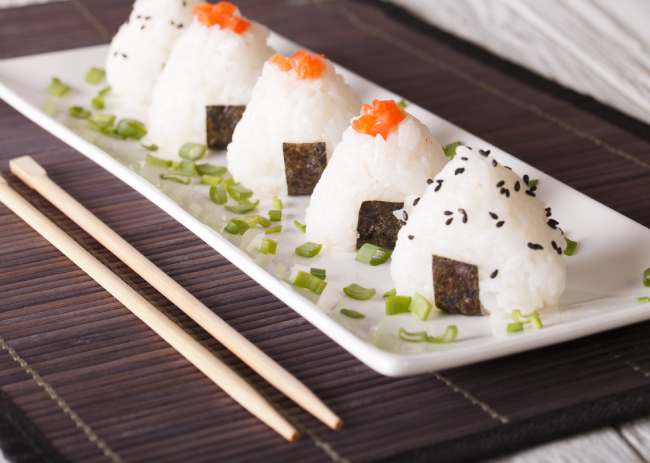
Salmon Onigiri: Step-By-Step Recipe
Ingredients
- 14 oz Japanese short-grain rice
- 2 Nori sheets
- Salt to taste
- 1 Salmon filet
Instructions
- To make salmon Onigiri, start by cutting a Nori sheet into three equal pieces. Next, grill a salmon filet and break it into flakes. Gather all the necessary ingredients. It includes a pinch of salt, cooked rice, the salmon flakes, a bowl of water and Nori sheets.
- To assemble the Onigiri, put the rice in a bowl and make a small dent in the centre. Add one or two teaspoons of salmon flakes to the dent. Wet your hands with water and sprinkle some salt (about two fingertips) on your palm. Rub your hands together to distribute the salt evenly.
- Take a handful of rice. Shape it into a triangle or round shape by pressing with both hands while rolling it several times. Repeat this process until all the rice and salmon are used up.
- Finally, wrap each Onigiri with a piece of Nori sheet. Serve and enjoy your delicious salmon Onigiri!
Notes
- Use short-grain sushi rice: Short-grain sushi rice is stickier than regular rice. It is perfect for making Onigiri. Rinse the rice before cooking to remove excess starch. Prevent it from becoming too sticky.
- Cook the rice: Furthermore, To make perfect Onigiri, you need to cook the rice. Use the right amount of water and follow the cooking instructions to ensure that the rice is tender.
- Use fresh salmon if possible: If using fresh salmon, cook it first and then flake it with a fork. In addition, If using canned salmon, drain the liquid before flaking it.
- Use flavourful ingredients: To make flavourful Onigiri, use ingredients. For instance, soya sauce, mirin, sake, and green onions season the salmon mixture.
- Let the rice cool: It's important to let the rice cool a little before shaping the Onigiri. If the rice is too hot, it will be difficult to handle and may fall apart.
- Keep your hands moist: Wet your hands with a little water before shaping the Onigiri. Do it to prevent the rice from sticking to your hands.
- Experiment with fillings and toppings: Onigiri can consist of a variety of fillings. Try different combinations of ingredients to find your favourite.
- Use plastic wrap or a tea towel to shape the Onigiri: Using this will make it easier to shape the Onigiri. It shapes without getting rice all over your hands.

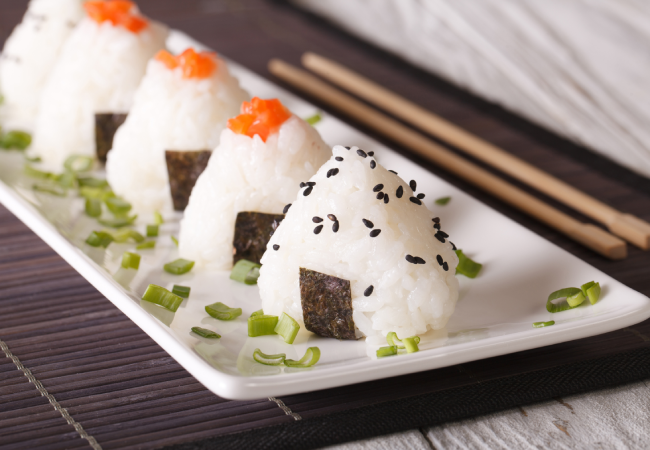
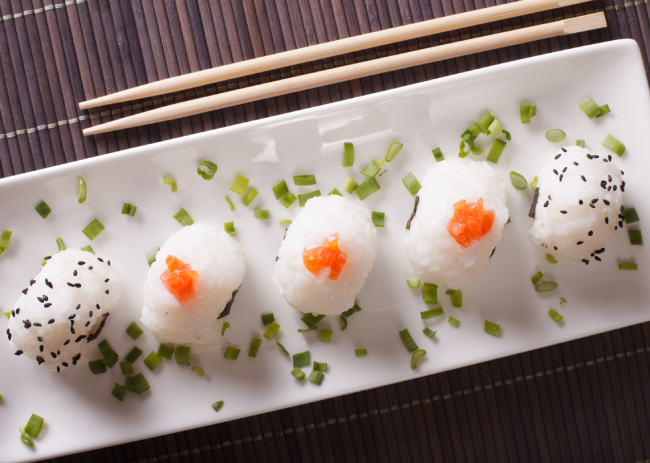
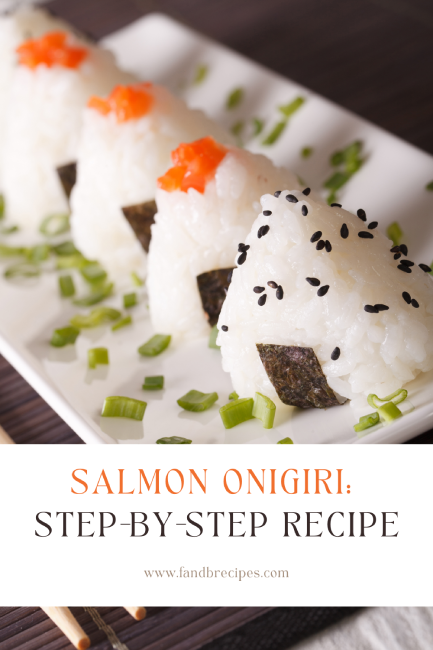

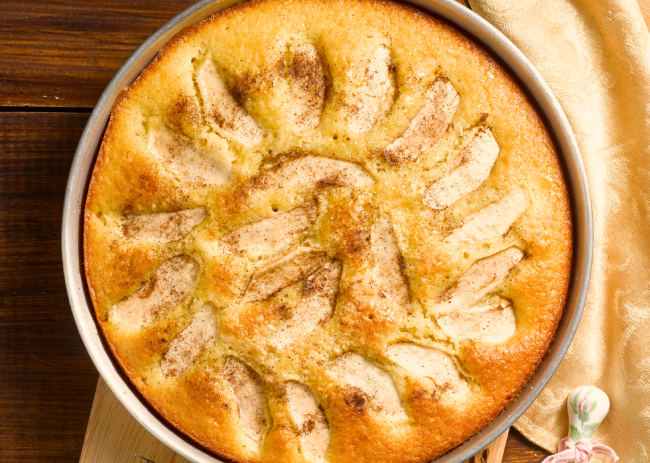
Tasty
good !!
yummiest
very yummy and tasty!
Salmon Onigiri-heard this name,But this article gave a simple answers to my questions as to, its origin how it is made,its stuffings etc…Thank’s to this article!!!!
must try the dish..!
Nice. Makes me want to try sushi
Impressive blog and informative one for unique recepies. Thanks for sharing with us
That’s delicious.. Thanks for sharing
Had never tried Onigiri before but this recipe turned out well for me. Thanks for sharing!
good in taste
After trying this recipe, I can’t wait to make it again and share it with friends and family.
Definitely was not a fan of onigari but always wanted to give it a try and guess what I’M IN LOVE WITH IT !